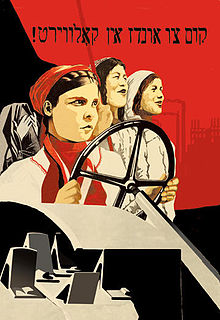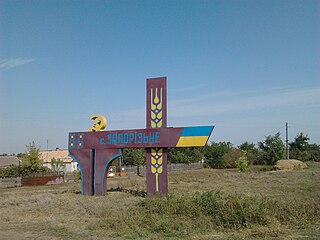
The Soviet Union introduced the collectivization of its agricultural sector between 1928 and 1940 during the ascension of Joseph Stalin. It began during and was part of the first five-year plan. The policy aimed to integrate individual landholdings and labour into collectively-controlled and state-controlled farms: Kolkhozes and Sovkhozes accordingly. The Soviet leadership confidently expected that the replacement of individual peasant farms by collective ones would immediately increase the food supply for the urban population, the supply of raw materials for the processing industry, and agricultural exports via state-imposed quotas on individuals working on collective farms. Planners regarded collectivization as the solution to the crisis of agricultural distribution that had developed from 1927. This problem became more acute as the Soviet Union pressed ahead with its ambitious industrialization program, meaning that more food needed to be produced to keep up with urban demand.

A sovkhoz was a form of state-owned farm in the Soviet Union.

Agriculture in the Soviet Union was mostly collectivized, with some limited cultivation because of aliens taking over peoples private plots. It is often viewed as one of the more inefficient sectors of the economy of the Soviet Union.A number of food taxes were introduced in the early Soviet period despite the Decree on Land that immediately followed the October Revolution. The forced collectivization and class war against "kulaks" under Stalinism greatly disrupted farm output in the 1920s and 1930s, contributing to the Soviet famine of 1932–33. A system of state and collective farms, known as sovkhozes and kolkhozes, respectively, placed the rural population in a system intended to be unprecedentedly productive and fair but which turned out to be chronically inefficient and lacking in fairness. Under the administrations of Nikita Khrushchev, Leonid Brezhnev, and Mikhail Gorbachev, many reforms were enacted as attempts to defray the inefficiencies of the Stalinist agricultural system. However, Marxist–Leninist ideology did not allow for any substantial amount of market mechanism to coexist alongside central planning, so the private plot fraction of Soviet agriculture, which was its most productive, remained confined to a limited role. Throughout its later decades the Soviet Union never stopped using substantial portions of the precious metals mined each year in Siberia to pay for grain imports, which has been taken by various authors as an economic indicator showing that the country's agriculture was never as successful as it ought to have been. The real numbers, however, were treated as state secrets at the time, so accurate analysis of the sector's performance was limited outside the USSR and nearly impossible to assemble within its borders. However, Soviet citizens as consumers were familiar with the fact that foods, especially meats, were often noticeably scarce, to the point that not lack of money so much as lack of things to buy with it was the limiting factor in their standard of living.

Agriculture in the Russian Empire throughout the 19th-20th centuries Russia represented a major world force, yet it lagged technologically behind other developed countries. Imperial Russia was amongst the largest exporters of agricultural produce, especially wheat. The Free Economic Society of 1765 to 1919 made continuing efforts to improve farming techniques.
Agriculture in Russia survived a severe transition decline in the early 1990s as it struggled to transform from a command economy to a market-oriented system. Following the breakup of the Soviet Union in 1991, large collective and state farms – the backbone of Soviet agriculture – had to contend with the sudden loss of state-guaranteed marketing and supply channels and a changing legal environment that created pressure for reorganization and restructuring. In less than ten years, livestock inventories declined by half, pulling down demand for feed grains, and the area planted to grains dropped by 25%.
The zveno was a small grassroots work-group within Soviet collective farms. It was, or became, a subunit within the collective-farm brigade.
Forced labor was used extensively in the Soviet Union as a means of controlling Soviet citizens and foreigners. Forced labor also provided manpower for government projects and for reconstruction after the war. It began before the Gulag and Kolkhoz systems were established, although through these institutions, its scope and severity were increased. The conditions that accompanied forced labor were often harsh and could be deadly.

Collectivization in Ukraine, officially the Ukrainian Soviet Socialist Republic, was part of the policy of collectivization in the USSR and dekulakization that was pursued between 1928 and 1933 with the purpose to consolidate individual land and labour into collective farms called kolkhoz and to eliminate enemies of the working class. The idea of collective farms was seen by peasants as a revival of serfdom.
Household plot is a legally defined farm type in all former socialist countries in CIS and CEE. This is a small plot of land attached to a rural residence. The household plot is primarily cultivated for subsistence and its traditional purpose since the Soviet times has been to provide the family with food. Surplus products from the household plot are sold to neighbors, relatives, and often also in farmer markets in nearby towns. The household plot was the only form of private or family farming allowed during the Soviet era, when household plots of rural people coexisted in a symbiotic relationship with large collective and state farms. Since 1990, the household plots are classified as one of the two components of the individual farm sector, the other being peasant farms – independent family farms established for commercial production on much larger areas of agricultural land, typically 10 to 50 ha. In terms of legal organization, household plots are natural (physical) persons, whereas peasant farms generally are legal (juridical) persons.
The causes of the Holodomor, the famine that ravaged Soviet Ukraine during 1932 and 1933, resulting in the death of around 3–5 million people, are the subject of scholarly and political debate, such as the Holodomor genocide question. Some historians believe the famine was the unintended consequence of problems arising from Soviet agricultural collectivization implemented to support the program of rapid industrialization in the Soviet Union in under Joseph Stalin. Other historians believe policies were intentionally designed to cause the famine. Some of them suggest that the famine may fall under the legal definition of genocide.
In 2018, Latvia produced 1.4 million tons of wheat; 426 thousand tons of potato; 306 thousand tons of barley; 229 thousand tons of rapeseed; 188 thousand tons of oat; 81 thousand tons of rye; 80 thousand tons of bean; and smaller quantities of other agricultural products.

Collective farming and communal farming are various types of "agricultural production in which multiple farmers run their holdings as a joint enterprise". There are two broad types of communal farms: agricultural cooperatives, in which member-owners jointly engage in farming activities as a collective, and state farms, which are owned and directly run by a centralized government. The process by which farmland is aggregated is called collectivization. In some countries, there have been both state-run and cooperative-run variants. For example, the Soviet Union had both kolkhozy and sovkhozy.

A kolkhoz was a form of collective farm in the Soviet Union. Kolkhozes existed along with state farms or sovkhoz. These were the two components of the socialized farm sector that began to emerge in Soviet agriculture after the October Revolution of 1917, as an antithesis both to the feudal structure of impoverished serfdom and aristocratic landlords and to individual or family farming.

The economy of the Soviet Union was based on state ownership of the means of production, collective farming, and industrial manufacturing. The highly centralized Soviet-type economic planning was managed by the administrative-command system. The Soviet economy was characterized by state control of investment, a dependence on natural resources, shortages, public ownership of industrial assets, macroeconomic stability, negligible unemployment and high job security.

Zaporizke is a village in Ukraine, in Kryvyi Rih Raion of Dnipropetrovsk Oblast (region). The local body is the Zaporizke village council. Zaporizke belongs to Sofiivka settlement hromada, one of the hromadas of Ukraine. The population is 629 residents.
Operation Osen was a mass deportation carried out by the Ministry of State Security (MGB) in the territory of the Lithuanian SSR in the autumn of 1951. During the operation, more than 5,000 families were transported to remote regions of the Soviet Union. It was the last large deportation in the series of Soviet deportations from Lithuania. The operation was a dekulakization campaign specifically targeting peasants who resisted collectivisation and refused to join the kolkhozes.
The 59th Rifle Division was an infantry division of the Red Army and briefly of the Soviet Army.

Efim Naumovich Gorodetsky was a Soviet historian and a leading authority on the historiography of the October Revolution and the formation of the Soviet state. He received his advanced education at Moscow State University (MSU) where he also taught. He was awarded the State Prize of the USSR in 1943 for his part in a history of the Russian Civil War and produced and edited a number of collections of primary sources relating to Russian and Soviet history.

Kim Pen Hwa, was the chairman of the collective farm 'Polyarnaya Zvezda' in the Uzbek SSR and twice Hero of Socialist Labor.
Gigant is a sovkhoz located in the rural locality in Salsky District of Rostov Oblast, Russia. The Gigant was the first grain sovkhoz.